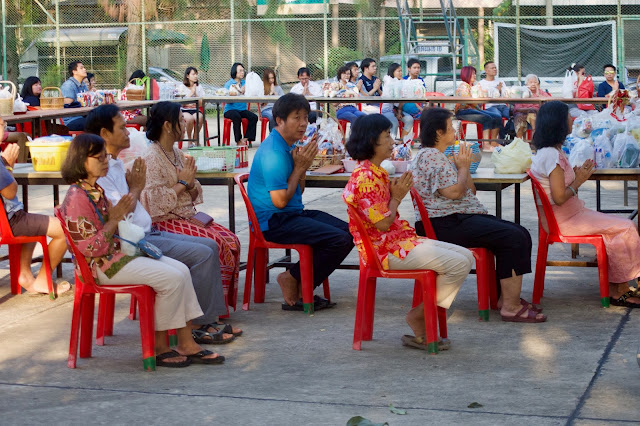Ayutthaya (official name "Phra Nakhon Si Ayutthaya"), a former kingdom and capital of Siam in what is now Thailand and designated world heritage site, is a treasure of an ancient city that has been carefully preserved as the modern city grew around it. Temple stupas and walls dot the city both inside and outside of the "old city," an island that is delineated by rivers that surround it. Ayutthaya was founded in 1350, the second capital of Siam. By 1700, it was the largest city in the world, and the trading center of Asia.
I have been to Ayutthaya many times, and each time I discover something new, even in places I have toured before.
Recently, I traveled with fellow photographer and Bangkok Photo Rambler Jeremiah Boulware north of Bangkok (about a 45 minute drive) and wandered the area of Ayutthaya south of the Chao Praya River. Although we usually have one or two sites in mind, we never have a set itinerary, but let the sights and back streets guide us.
Following are photos of our half day ramble. It is always my intent to publish scenes that one is not likely to find on a post card, but that tell stories of the place and the people who live and visit there. I hope you enjoy the tour.
All photos © by the author unless otherwise noted. It is illegal to use any photo for any purpose without permission. If you are interested in using any of the images, please contact me at jsscience@yahoo.com.
WAT YAICHAI MONGKOL
 |
| The base of a large stupa ("chedi") at Wat Yai Chai Mongkol. The temple was built in 1357 |
 |
| View of one of the many Buddha statues on the grounds. |
 |
| View of the central stupa of Wat Yai Chai Mongkol. |
 |
| Scores of Buddha statues face and surround the central chedi. It is a very popular destination for Thai Buddhists and foreign tours. Here a devotee pays his respects. |
 |
| From the walkway that circles the chedi about halfway up, I noticed Jeremiah photographing one of the temple's cats. |
 |
| Jeremiah captures a scene from the chedi. |
 |
| A garland of marigolds and jasmine laid on a ledge of the central chedi. |
 |
| Reclining Buddha, partially seen through breaks in the wall. |
 |
| Many Thai people, and some foreigners, dress in traditional Thai clothing when visiting important temples. Here some teens document their visit. |
 |
| This wooden building on the temple grounds has intricately carved panels and doors. |
 |
| For a small donation, people receive a gold colored sash to put around one of the Buddha statues. |
 |
| It is interesting how "tuk tuks" vary from locale to locale. I have not seen any alike from different cities. This is the "Ayutthaya design." |
CHINESE TEMPLE
 |
| We attempted to find some of the old European settlements in the area, but instead came across a riverside Chinese temple. |
 |
| A reflection inside the temple. |
 |
| A well used candelabra and urn for placing devotion candles and incense sticks. |
 |
| Jeremiah's reflection captured in a small glass display case with a sculpted likeness of a respected monk. Often they are life-size. |
BETWEEN WATS...
 |
| A wrong turn took us to a U-turn and a serendipitous scene of a family bringing in their fish nets on a small artificial lake. |
WAT PHUTTHAISAWAN
 |
| At our next stop, Wat Phutthaisawan, a family was gathered to pay respects to a deceased family member. A monk was presiding over the ceremony, while another recorded the event on his phone. |
 |
| This jolly concrete laughing monk doll sits on the ledge of a small stupa. Several others of varying sizes with the same happy face had been placed around the stupa. |
 |
| Tiny dancing figures adorn one of the stupa ledges. |
 |
| This room may seem familiar to some: it was where scenes from the movie "Mortal Combat" were filmed. Here Jeremiah focuses on details of a figure. |
 |
| This scene was so engaging that I stood right in the line of the photographers as I took my own shots! One does not often see monks photographing other people, particularly women. As we observed them, it was apparent that they were involved in some kind of photo shoot. Still, it was very unusual. |
 |
| A reclining Buddha as seen through the window of one of the ruins. |
 |
| Another scene from the photo shoot. |
 |
| An entryway to the main temple |
 |
| Detail of the central chedi (stupa, or prang), which is in Khmer style. |
 |
| Two visitors take photos of each other outside of the main temple. |
 |
| A young boy awaits his family among the Buddhas in one of the building ruins. |
 |
| On either side of the main chedi (stupa) are two rooms housing very large Buddhas. |
 |
| On the ceiling are hundreds of bats. |
 |
| A depiction of the last supper is ubiquitous in churches but this is the first one I have seen in which the disciples are seated around the table instead of on one side. This is a beautiful ceramic relief. |
ALONG THE WAY...
 |
| On our way to a coffee shop at the end of a very hot morning, we passed this body shop where work was being done on a tuk tuk. |
 |
| This lovely family had a stall at a small flea market just inside of the old city. |
To view an album of our Ayutthaya photo ramble, including beautiful photos by Jeremiah, go to Bangkok Photo Rambles on Facebook: @photoramblers



























